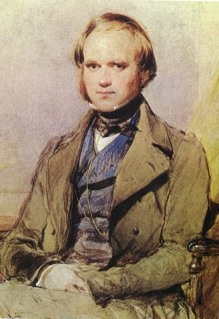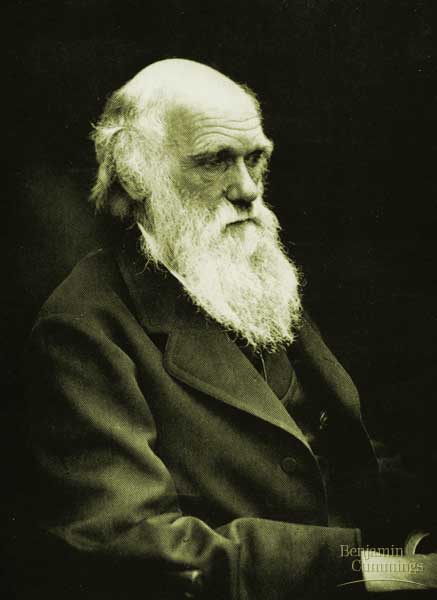

Tomorrow is the 150th Anniversary of The Origin of Species.
"Is everything connected to terriers?" a friend of mine once asked me.
"No," I replied. "Everything is connected to everything."
And so it is. Take Charles Darwin, and his treatise on earth worms.
To begin with, young Charles Darwin was a youth of the right sort. He spent so much time with his dog that his father did not think he would ever amount to much. "You care for nothing but shooting, dogs and rat-catching, and you will be a disgrace to yourself and your family," his father lectured.
Which was nearly true.
Darwin entered college planning to be a clergyman (an occupation that promised to leave leave a lot time for chasing butterflies), but there was the little matter of God.
It was not that Darwin did not believe, exactly. It was just that there was not much evidence that God -- as pushed and interpreted by the Church -- actually existed.
And so when young Darwin got a chance to go on a round-the-world cruise as a young unpaid naturalist, he snapped up the opportunity. Ironically, Darwin's five-year voyage was on a ship called the HMS Beagle.
Though Darwin made a great deal of observations on the trip, he did not come up with his theory of evolution while on board ship. That came many years later, and only after observing the rapid transformation of domestic livestock -- including dogs -- that was occurring thanks to the rise of the Enclosure Movement, and the advent of controlled sire selection as practiced by Robert Bakewell and others.
It is worth noting that Darwin (1809-1882) lived during the period when terriers were being "speciated" into breeds, and was a contemporary of the Reverend John Russell, creator of one of the first -- and certainly oldest -- working terrier breeds.
As a grown man Darwin continued to have large numbers of dogs about, and they are featured prominently in his correspondence -- dogs by the name of Dash, Nina, Pincher, Sheilah, Spark and Sappho.
On fact, one of these dogs, Sappho, is mentioned in Darwin's work on The Variation of Animals and Plants Under Domestication:
"The following case has been communicated to me on good authority, and may, I believe, be fully trusted: a pointer-bitch produced seven puppies; four were marked with blue and white, which is so unusual a colour with pointers that she was thought to have played false with one of the greyhounds, and the whole litter was condemned; but the gamekeeper was permitted to save one as a curiosity. Two years afterwards a friend of the owner saw the young dog, and declared that he was the image of his old pointer-bitch Sappho, the only blue and white pointer of pure descent which he had ever seen. This led to close inquiry, and it was proved that he was the great-great-grandson of Sappho; so that, according to the common expression, he had only 1/16th of her blood in his veins."
In fact, the person with the "old pointer-bitch Sappho", was none other than Darwin himself!
Darwin's observation that coat color had a genetic origin and that some characteristics (good, bad and unusual) could pop up in progeny several generations down the line was right on the money. We now attribute this phenomenon to the power of recessive genes -- a power first noted (as far as I know) in Genesis 30:25-43, in which Laban and Jacob work out a deal for wages (to be paid in sheep and goats) which Jacob wins despite Laban's cheating.
Though Charles Darwin had numerous dogs over the course of his life, he was particularly fond of terriers, and counted one of them, a white fox terrier by the name of Polly (what we would now call a Jack Russell terrier), as his closest out-of-doors walking companion at the end of his life.
It was Polly that led, by a circuitous route, to Darwin writing his last great work on earth worms.
When he moved into the house at Downe in Bromley, in the Sussex Region of England, Darwin bought a small adjoining field and created there a "sandwalk" where he could pace in thought with his dog by his side.
Upon purchasing the land for the sandwalk, Darwin had treated a portion of the soil with a layer of broken chalk (probably to knock down soil alkalinity) and another with coal ash (probably to increase phosphorous), and in the middle of the field, he planted a copse of trees. The sandwalk circled the whole.
Darwin counted his turns around the sandwalk by kicking flints to a corner of a turn. When he started out, shortly after the sandwalk's construction, there were a lot of flints in the field since it had been plowed prior to his acquisition of the property. As the years passed, however, Darwin notice that there seemed to be fewer and fewer flints about, and it was only the digging of his terrier, Polly, that told them where they had gone -- they lay just beneath the surface of the soil.
Somewhat perplexed, Darwin discovered that all the flints that had existed on his land all those years before were, in fact, still there -- lying just beneath the soil and covered up, ever so slowly, by the action of millions of worms tossing their castings out of their burrows.
Darwin had workers dig a trench at the location where the broken chalk had been put down some 29 years earlier, and there he found the chalk, now lying seven inches below the surface. Simple arithmetic suggested that worms on his property were building up soil at the rate of about 0.22 inches a year, and that over time, such action could result in entire cities being buried by the actions of worms alone. An excavation at the site where the ash had been layed down showed the worms were similarly employed burying that material, and at about the same rate of speed.
Darwin's observations about worms were turned into his last major work, entitled: "The Formation of Vegetable Mould Through the Action of Worms With Observations of Their Habits".
But what of Polly, the dog that helped start this line of inquiry? Polly got old with Darwin and, a few days after Darwin died in April of 1882, she was put down -- fed to the worms if you will. Or gone to ground, if you prefer.
In the picture below of Darwin's study at Down House (spelled differently from the village of Downe where it is located), can be seen a basket in front of the fire place -- Polly's basket.
That basket (or a version of it) is still in Darwin's study to this day -- a small memory of an old man's beloved terrier who, in her own small way, did her bit for science.

.
No comments:
Post a Comment